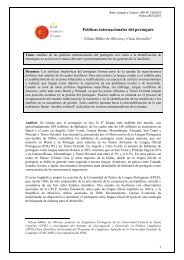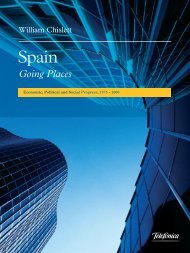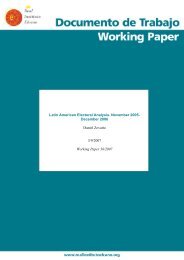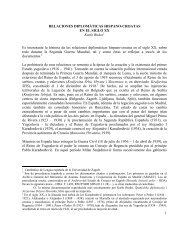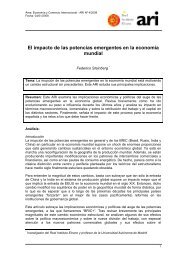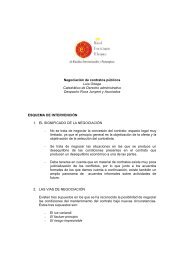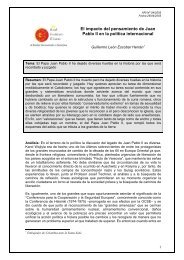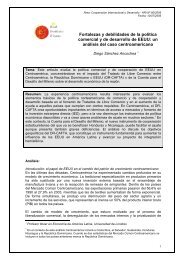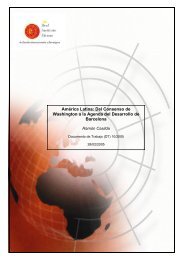Spain and the United States - Real Instituto Elcano
Spain and the United States - Real Instituto Elcano
Spain and the United States - Real Instituto Elcano
You also want an ePaper? Increase the reach of your titles
YUMPU automatically turns print PDFs into web optimized ePapers that Google loves.
128<br />
Exhibit 7.3 International Labour Costs*<br />
SPAIN AND THE UNITED STATES<br />
is slowly drifting eastward. <strong>Spain</strong> has traditionally been an export market, but<br />
<strong>the</strong> gap between exports <strong>and</strong> imports of vehicles has gradually been narrowing<br />
since 2000, <strong>and</strong> in 2004 imports from <strong>the</strong> EU were higher than exports to <strong>the</strong><br />
EU. One of <strong>the</strong> reasons for this is <strong>the</strong> opening of new plants in eastern Europe.<br />
<strong>Spain</strong>, however, is not an isolated case; relocation is part of a growing<br />
trend in Western Europe. None<strong>the</strong>less, it could be more vulnerable than o<strong>the</strong>r<br />
countries because, as well as rising costs in <strong>the</strong> manufacturing sector (<strong>the</strong>y are<br />
now not far off Italy’s), <strong>the</strong> country lags behind in knowledge <strong>and</strong> innovation<br />
indicators in <strong>the</strong> broadest sense. According to a study on <strong>the</strong> relocation of<br />
companies in <strong>Spain</strong>, <strong>the</strong> most threatened sectors are transport equipment,<br />
electrical <strong>and</strong> electronic equipment, rubber <strong>and</strong> plastics. 5 These sectors<br />
represent 15% of <strong>Spain</strong>’s industrial sector <strong>and</strong> are all areas with US companies.<br />
Improving <strong>Spain</strong>’s competitiveness involves a lot more than labour costs,<br />
which in <strong>the</strong>mselves do not make a country uncompetitive provided it offers<br />
o<strong>the</strong>r advantages, such as superior product quality, <strong>and</strong> can provide value<br />
added. Finl<strong>and</strong> is a case in point. Its labour costs are much higher than <strong>Spain</strong>’s<br />
<strong>and</strong> yet it is regularly among <strong>the</strong> world’s ten most competitive economies. The<br />
problem for <strong>Spain</strong> is that its rising labour costs are combined with o<strong>the</strong>r<br />
factors, such as an education system that is not producing <strong>the</strong> skills <strong>and</strong> training<br />
levels required by companies, <strong>the</strong> lacklustre behaviour of productivity, low<br />
spending on R&D <strong>and</strong> labour market laws that are still too rigid for <strong>the</strong> firing<br />
of people on permanent as opposed to temporary contracts. The situation of<br />
5. See El riesgo de deslocalización industrial en España ante la ampliación de la Unión Europea, by Lluis<br />
Torrens <strong>and</strong> Jordi Gual (IESE Business School, February 2005).



